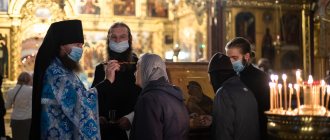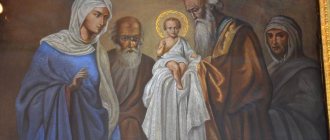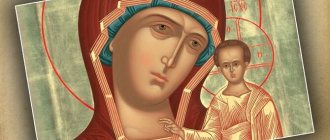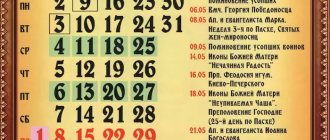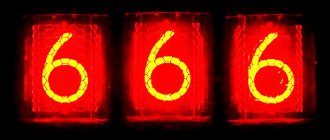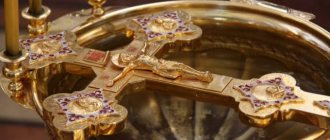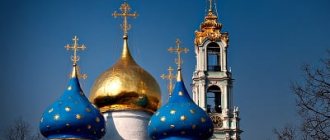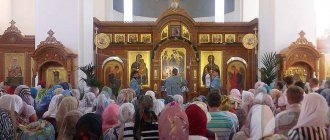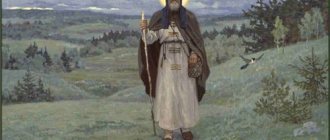Twelfth fixed feasts of the Lord and the Mother of God.
Differences and features
Divine services on the very days of the great twelve holidays are dedicated exclusively to the event being celebrated, which is expressed in the changing parts of the service (readings, prayers, chants).
The outer side of the service on these days, in accordance with the lordship and grandeur of the events being remembered, reaches complete solemnity. The Church “puts on bright clothes,” in “the entire brightest dignity,” as the Charter says about the Easter vestments, and performs divine services in the full illumination of the temple. The clergy themselves put on vestments corresponding to the content of the holiday: on the Lord's holidays - vestments in the color of gold (a symbol of triumph), on the Mother of God - blue or white (a symbol of innocence and virgin purity).
Note.
On the Lord's holidays, it is considered generally accepted to wear vestments in the color of gold, but for the Epiphany, Transfiguration and Ascension, vestments of white color are used, for the Exaltation - purple or red, for the Feast of the Entry of the Lord into Jerusalem - the color of gold (in practice, vestments of green color are often found and allowed), on Pentecost - the color of gold, and at Vespers on the same holiday - green in flowers.
For Easter, the colors of the vestments are white and red. On other holidays, vestments are: on angelic holidays - white, on apostolic holidays - yellow, on saints' holidays - the color of gold, on venerable holidays - green (a symbol of hope and peaceful deeds among green desert forests), on martyrdoms - red (a symbol of the suffering of the saints).
On great holidays, singing predominates over reading during services, which serves as an expression of the joyful state of those praying. On some of the twelve feasts, the Church, from ancient times, determined not to kneel, for it is more fitting for those celebrating to stand upright, in order to express triumph by the very position of the body. Therefore, the Charter directly says: “On the week (that is, Sunday), and on the Master’s Feast, and on Pentecost, the knees are not bowed” (Typikon, Chapter 2).
Finally, the Church brings spiritual joy and celebration into the homes of Christians, weakening or completely omitting fasting on these days and performing doxologies in the homes themselves.
Icons of the Twelfth Holidays
Of all the events of New Testament history, the Church Fathers identified twelve of the most important. These holidays are called the twelve and are dedicated to the memories of the earthly life of Christ and the Virgin Mary. The holiday icons dedicated to these events have their own characteristics.
Bead embroidery Christmas
Christmas
. The iconography of the holiday glorifies the incarnation of God in man. The main elements of the image are the cave and the Star of Bethlehem, which led the Magi to the Baby. The main composition is a swaddled Baby in a manger, the Virgin Mary reclining next to Him, Joseph sitting, animals near the manger. Additional elements that may not be present are angels praising Christmas, the wise men and the shepherds. On many, especially ancient Russian shrines, there is a scene of the Ablution (rite of purification with water) of Christ.
Entry of the Lord into Jerusalem
. The iconography glorifies the most solemn event in the earthly life of Christ - He enters Jerusalem and the people greet him as the King whose coming the prophets predicted. The main composition is Christ riding on a donkey, the apostles following Him and general popular rejoicing. The indispensable elements are the Mount of Olives on the left side of the image and the city of Jerusalem on the right.
Epiphany or Epiphany
. Holiday shrines dedicated to the event glorify the moment when the Lord first appeared (appeared) to those gathered as God. The main figures of the composition are the Savior being baptized and John the Baptist (Forerunner) blessing him. Above Christ in the segment of the sky there is a dove depicted, and in many ancient Russian versions - the God of Hosts.
Candlemas
. On the fortieth day after Christmas, pious parents brought the Baby to the temple. There he was met by Elder Simeon, who had a prediction that he would leave the world as soon as he saw the Savior, and righteous Anna the Prophetess. This is the meaning of the composition. As a rule, the figures are depicted against the background of the steps to the temple. This element in icon painting has a deep symbolic meaning.
Annunciation
. This day is considered by the Church to be the day of universal salvation. Through the Virgin Mary, God became incarnate and became man. The iconography glorifies the moment when the Archangel Gabriel communicated the Good News to the Most Pure Virgin. It is quite diverse. The moment of the meeting takes place at the well, or in Joseph’s house for yarn (the main story), or simply against a golden background.
Ascension
. On the fortieth day after the Resurrection, the Lord ascended to Heaven. Christ is depicted in triumph, as he will come to judge the world. This is the iconography of Pantocrator (Lord Pantocrator). At the bottom of the composition are the apostles observing this event and, invariably, the Blessed Virgin Mary.
Holy Trinity embroidered with beads and stones
Trinity or Pentecost
. Entire scientific works have been written about the iconography of the Trinity. It is impossible to portray God because no one has seen Him. According to the canons, only symbolic images are permissible. The festive icons of Pentecost, in the language of iconography, convey the story of the descent of the Holy Spirit on the apostles gathered in the Jerusalem upper room.
Transfiguration
. The Lord at Tabor revealed to the apostles his Divine nature through transformation. The main characters of the composition are the transformed Christ, Moses and Elijah. Moses holds in his hands the book or tablets of the Covenant. The iconography can be supplemented by the image of the apostles who came to Tabor along with the Savior.
Exaltation of the Cross
. Even a person with little knowledge of church history can easily determine what event is glorified in this image. In the center of the composition is a Cross on a raised platform. He is supported by several clergy. Other parts of the image may differ in different editions.
Dormition of the Blessed Virgin Mary
. The icon depicts the mourning apostles around the body of the Virgin Mary. At the top of the image is Christ with the soul of the Most Pure Mother.
Nativity of the Blessed Virgin Mary
. The iconography glorifies the birth of the Mother of the Lord. Among the images of the twelve holidays, the style and structure of this icon is the most earthly. Anna sits or reclines on the bed. She is served by women. The midwife and her maids wash the Virgin Mary in the font and present Her to her mother. In some depictions, Mary is depicted sleeping in a cradle.
Twelfth holidays calendar 2022, 2021
Next year 2022, the moving holidays will fall on the following dates:
- Entry of the Lord into Jerusalem April 12;
- Ascension of the Lord May 28;
- Trinity June 7th.
Fixed holidays do not change their dates, so we will not repeat them. They can be viewed in the previous paragraph.
Iconography of great celebrations
It should be noted that all the celebrations presented have their own symbolic images. The divine face of one of the celebrations in honor of which the church was consecrated can be located on the iconostasis in the local row or below in the 2nd row.
In those churches where all the icons of the twelve feasts are presented, they are mainly placed between the local and Deesis rows.
The Twelfth Feasts is the name of the cycle of the twelve most important annual holidays of the Russian Orthodox liturgical calendar.
Twelve (from the Old Russian “two on ten” - twelve) most important church holidays after Easter. Dedicated to the events of the earthly life of the Savior and the Virgin Mary. Easter, as a “holiday holiday,” is outside this classification.
We advise you to study Prayers to St. Macarius the Great
The twelve feasts distinguish the Lord's feasts, associated with the earthly life of Jesus Christ, and the Theotokos feasts, associated with the earthly life of the Mother of God.
According to the liturgical principle, within the annual circle, these holidays are divided into two categories: Fixed (immovable) holidays: they always fall on a strictly defined day of the month, regardless of the day of the week, which changes annually. These include nine twelfth church holidays:
Twelfth Feasts
Movable (moving) holidays. The moving part of the church calendar moves along with the date of Easter, which changes from year to year. All “moving” holidays are counted from Easter and move in the space of the “secular” calendar along with it.
Twelfth moving holidays:
The twelfth holidays each have one forefeast day, with the exception of the Nativity of Christ, which has 5 forefeast days, and Epiphany, which has 4 forefeast days. The number of days of post-feast varies from 1 to 8 days, depending on the greater or lesser proximity of some holidays to others or to days of fasting. Some of the Lord's holidays, in addition, are preceded and concluded by special Saturdays and weeks (Sundays). The services of the twelve feasts of the fixed circle are in the Menaions of the Months (* note - the Menaia (Greek “month”) is a liturgical book containing the texts of the variable prayers of the fixed annual liturgical circle. The Menaions are Menaea Monthly, the Menaions Festive and the Menaions General). The services of the twelve feasts of the moving circle are in the Triodions - Lenten and Colored (*note - Triodion - (Greek three-song) - a liturgical book containing the texts of the changing prayers of the moving annual liturgical circle). At the festive all-night vigil of all twelve feasts, a lithium is served. In Russia, until 1925, the twelfth holidays were both church and civil.
Great non-twelfth holidays:
- According to the flesh, the circumcision of our Lord Jesus Christ and the memory of St. Basil the Great—January 14
- Nativity of John the Baptist - July 7
- Holy Chief Apostles Peter and Paul—July 12
- Beheading of John the Baptist—September 11
- Intercession of the Blessed Virgin Mary—October 14
On the day of the great holiday, an All-Night Vigil is celebrated. In liturgical books they are marked with a red cross in a circle. Each twelfth holiday and Easter has a pre-celebration, post-celebration and giving. The holidays of the Nativity and the Beheading of John the Baptist, the Circumcision of the Lord, the Protection of the Most Holy Theotokos, and the Holy Chief Apostles Peter and Paul have no forefeast, afterfeast, or giving away.
Icon of selected twelve and great holidays
Painting – early 17th century, Stroganov master (?), inset into a 19th century board, frame – 19th century.
Wood, gesso, tempera, gilding (icon); metal, gilding, embossing, engraving (setting)
30.5 x 25.7 cm (inset size 18.8 x 14.7 cm)
About the icon: The icon is the work of a remarkable miniaturist. It is characterized by the traditional scale relationship between figures and background images, and the proportionality of the figures. The preparatory drawing, shining through the transparent colorful surface, is expressive and free. The personal letter, the architectural forms, the design of the slides, and the special miniature size suggest that the icon belongs to the circle of Stroganov masters. It has great artistic and historical value and is a monument of museum significance...read more
What are the church holidays today?
Date today:
Thursday, August 13, 2022 (What date is today according to the old style: July 31) 10th Week after Pentecost Hieromartyr. Veniamin, Metropolitan of Petrograd, and with him the Venerable Martyr. Sergius Shein and martyred. Yuri Novitsky and Ioann Kovsharov (1922) Forefeast of the origin of the honorable trees of the Life-giving Cross of the Lord. Eudokim the Cappadocian (IX) Which saints do we remember today:
Holy.
Herman, Bishop of Auxerre (448). Martyr Julitta (304-305). Reverend Martyr Dionysius of Vatopedi (1822) (Const.). Day of Remembrance of Confessors and New Martyrs:
Martyr.
Maxim Rumyantsev (1928); sacred martyr Vladimir Kholodkovsky presbyter (1937); sacred martyr Presbyter John Rumyantsev, St. Konstantin Razumov, confessor, presbyter, martyr Anna Serova and saint. Elisaveta Rumyantseva confession. (after 1937). Marriage:
They do not perform a wedding.
Reading schedule for today:
Gospel and Apostle: In lit.: - Apostle: 2 Corinthians 1:1-7 Ev.: Matthew 21:43-46 Psalms: In the morning: - Psalm 91-100; Psalm 101-104 For eternity: - Psalm 105-108
Orthodox calendar
The calendar in Rus' was called the monthly calendar. It covered and described absolutely the entire year of life of the peasants; in it, each day corresponded to certain holidays or weekdays, folk signs, and all kinds of weather phenomena. The Orthodox calendar is divided into two parts according to the principle of its moving and fixed parts. The most significant days of celebration and fasting for a Christian are determined by Easter. It is by taking into account all the factors of the lunisolar calendar that the Easter holiday is first calculated - the most important and main holiday in all senses. The calculation of the first spring full moon follows immediately after the vernal equinox. The exact date of Easter itself moves within 35 days, that is, from April 4 to May 8. Thus, the date of this holiday moves, but the day of the week, that is, Sunday, remains unchanged. Periods of fasting and other traditionally religious days associated with the celebration of this unique holiday for believers are counted based on this principle.
Icon OF THE COVER OF THE MOTHER OF GOD
Last third of the 16th century, Novgorod
Wood, pavolok, gesso, tempera, gilding
28.5x24x1.4 cm
About the icon: The plot is borrowed from the life of St. Andrei Yurodivy (X century). The Mother of God, accompanied by saints, appeared to St. Andrew and his disciple Epiphanius in the Blachernae Church in Constantinople (invisible to the rest of those present). Having offered up a prayer, She spread her veil over those praying as a sign of patronage and protection. The Feast of the Intercession of the Virgin Mary was established not in Byzantium, but in Rus', in the 12th century. (obviously, first in Kyiv, then in Vladimir) ....read more
The twelfth feast of the Mother of God: when is it celebrated, icons, how to arrange
There are many of us like-minded people and we are growing quickly, we post prayers, sayings of saints, prayer requests, and timely post useful information about holidays and Orthodox events. Subscribe. Guardian Angel to you!
For every believer, the Great Church holidays are a very important event that receives great attention. The twelfth holidays come immediately after the Resurrection of Christ
There are only 12 of them: 7 great holidays glorifying Jesus Christ, the Son of God and 5 - the Blessed Virgin Mary. Each twelfth feast of the Mother of God has its own characteristics.
The main Mother of God holidays in Orthodoxy
According to the Orthodox church calendar:
- First on the list is the Birth of the Blessed Virgin Mary - one of the annual holidays, celebrated with the All-Night Divine Liturgy.
- Next, the Entry into the Temple of the Most Pure Mother of God - this day for every person should symbolize the salvation of the entire human race.
- The very word Annunciation of the Most Holy Theotokos means good news about the liberation of a long-suffering and sinful people, their protection from all troubles.
- The Feast of the Assumption testifies that the Mother of God did not die, but to this day continues to trust for the entire people, to help the suffering, the poor, families with children, those who have lost their path, which the Almighty has prepared and is now in constant search.
- And the last twelve-tenth feast of the Theotokos is the Presentation of the Lord - the meeting of Simeon from the Son of God, the long-awaited moment of the collision of the Old and New Testaments: the Law of God and the Law of unconditional love for the Almighty, brought to Earth by Jesus.
All named church holidays have a clearly established date, which does not depend on other Great holidays. If, according to the calendar, a holiday falls during the working week or on a Saturday, then it is celebrated only on the occasion of this significant day in the history of the Orthodox Church, but if it falls on a Sunday, then two services are held simultaneously.
When are the twelve feasts of the Lord celebrated?
The Church celebrates 7 major holidays, including:
- Christmas, which is celebrated on January 7,
- Epiphany January 19,
- Exaltation of the Cross September 27,
- Transfiguration August 19.
We advise you to study Congratulations on the Presentation of the Lord in prose
All of them have a clearly fixed date and are never postponed.
Entry of the Lord into Jerusalem (Palm Sunday - a week before Easter), Ascension of the Lord, Pentecost. depend on what day the Holy Resurrection of Christ - Easter - falls.
All the holidays we list have special days that are necessary for special preparation:
- Days that fall immediately before a significant date;
- Days after the holiday;
- The last day of worship after the festival.
The Birth of Christ is celebrated most of all - 5 days, Epiphany - 4 days, and all others - 1 day, much depends on the number of days of fasting.
Icons of the Twelfth Holidays
The icons carry information about the main facts of the life of the Son of God and his Mother. Each author tried to convey the true meaning of what was depicted and put his heart and soul into it.
In all churches, cathedrals and temples on such special days, it is customary to place icons in the 3rd row, between the predictive and Deisis rows. Each of the holidays that were described earlier has one or more icons that depict different interpretations of Earthly events.
The icon of the Resurrection of Christ with the twelve feasts has a very deep meaning and great significance. This celebration is given great importance, because by his resurrection the Son of God proved that there is life after death. All believers sincerely cry out with prayers and rejoice at the Great Day for 50 days, until the Day of the Most Holy Trinity.
This icon helps you find your purpose, strengthen your spirit, and believe in your own strength.
The order of placement of icons of the twelve holidays
Every believer has in his home icons of the Creator, his Son and the Mother of God. The icons should be placed in the house on the eastern side in order to pray at sunrise.
In the center there should be the face of Christ, on the right side of it is the holy image of the Virgin Mary, and on the left is the icon of the Holy Trinity. It is best to stir it in each room, away from any household appliances. If possible, it is better to place all icons in an icon case, lighting a candle every time a prayer is read.
If you wish, you can increase the number of holy images, adhering to the basic church rules.
The Lord is always with you!
Watch also the video about the twelve feasts of the Mother of God:
Twelfth feasts according to the chronology of the church year
Nativity of the Blessed Virgin Mary - September 21 (September 8, old style); Exaltation of the Cross of the Lord - September 27 (September 14, old style); Entry into the Temple of the Blessed Virgin Mary - December 4 (November 21, old style); Nativity of Christ - January 7 ( December 25, old style); Epiphany - January 19 (January 6, old style); Presentation of the Lord - February 15 (February 2, old style); Annunciation of the Blessed Virgin Mary - April 7 (March 25, old style); Palm Sunday - the nearest Sunday before Easter, a moving holiday; Ascension of the Lord - the 40th day after Easter, always on Thursday, a moving holiday; Feast of the Holy Trinity (Pentecost) - the 50th day after Easter, always on Sunday, a moving holiday; Transfiguration of the Lord - 19 August (August 6, old style); Dormition of the Virgin Mary - August 28 (August 15, old style).
Sources:
- https://dailyhoro.ru/article/dvunadesyatyie-pravoslavnyie-prazdniki-chto-eto-takoe-i-kak-ih-otmechat/
- https://omolitvah.ru/ikony/ikony-dvunadesyatyh-prazdnikov/
- https://1001molitva.ru/prazdniki/dvunadesyatye.html
- https://ikona-i-molitva.info/chto-takoe-dvunadesyatye-prazdniki-pravoslavnoj-cerkvi/
- https://ruvera.ru/dvunadesyat
You might be interested in:
| 1. Liturgics – Archbishop Averky (Taushev) |
| 2. Liturgics. Gymnography and eortology – Archimandrite Cyprian (Kern) |
| 3. Liturgics: Sacraments and Rites - Part I. About special Services performed by the Church on a well-known occasion or according to the needs of Christians - Hermogenes Ivanovich Shimansky |
| 4. Lectures on liturgics - Professor Nikolai Fomich Krasnoseltsev |
| 5. Explanatory Typicon - CANON - Professor Mikhail Nikolaevich Skaballanovich |
| 6. Dogmatic Theology - SECTION III. THE CONCEPT OF THE SACRAMENTS AS A MEANS OF SANCTIFYING MAN – Archpriest Oleg Davydenkov |
| 7. Sacraments and rituals of the Orthodox Church - Archpriest Gennady Nefedov |
| 8. Rules for singing troparions and kontakions at the entrance to the Liturgy - Professor Nikolai Dmitrievich Uspensky |
| 9. Interpretation on proverbs from the book of Genesis - Bishop Vissarion (Nechaev) |
| 10. A guide to studying the rules of worship of the Orthodox Church - Archpriest Konstantin Nikolsky |
Notes
- The days in this article are indicated as is customary in everyday life of the modern Russian Orthodox Church, that is, the number is indicated according to the Julian calendar (old style) and then the date to which this number corresponds according to the Gregorian numeral in the 20th and 21st centuries. It should be borne in mind that only a part of the churches (or jurisdictions - see Old Calendar Churches), including the Russian one, continues to adhere to the Julian calendar; most of the others, including Constantinople, switched to the New Julian calendar in the 20th century. For such churches, the first date given is the day of celebration according to the Gregorian calendar.
- Not all of the Lord's
and
Theotokos'
feasts are
Twelve
and
Great
;
some of them are medium
and even
small
holidays. - The Typikon (Moscow, 2002, p. 1019 ҂аѳ҃ι) on Wednesday of the 6th week of Pascha (the celebration of the Easter holiday) provides for the singing of three canons: Easter with Irmos on 6, blind on 4 and the forefeast of the Ascension on 4. However, in many In churches, only Easter services are performed.
- Litiya, according to the Charter, must be served at all All-Night Vigils, without exception. But in Russian parish practice, lithium is very often served only on twelfth and patronal feasts.
- At bishops' services, the second festive antiphon of the holiday is sung with the chorus.
- if no other holidays occur on this day
Why is Easter not one of the twelve holidays?
But you are probably wondering: why is everyone’s favorite Easter, the day of the Bright Resurrection of Christ, not among these holidays? The greatness and significance of the events of Easter for Orthodox Christians is so great that this date, the day on which the Crucified Jesus Christ rose from the dead, rose from the grave after a painful death, is usually placed above the twelve holidays. The Resurrection of Christ, as it were, crowns these important memorable dates. By the way, on the icon of the twelve holidays, the fragment dedicated to Easter is traditionally depicted in the middle, while the events of the twelve holidays are placed around the perimeter of the icon.
Icon depicting the twelve feastsIcon of the RESURRECTION OF CHRIST
Beginning of the 17th century, Stroganov master March 4
Wood, pavolok, gesso, tempera, gilding
31.8x27.5x2.6 cm (with ark side)
About the icon: The iconography combines two plots - “The Descent into Hell” and “Rising from the Grave.” The composition “Descent into Hell” was formed by the 11th century. based on New Testament texts (Matthew 27: 52; I Peter 3: 18-19; Eph. 4: 9), the apocryphal Gospel of Nicodemus and patristic writings. In these! sources say that after death on the cross, Christ descended into hell as the King of Glory and delivered human souls from the power of Satan...read more
What do the twelve holidays mean?
The Twelfth Celebrations are twelve Orthodox Christian celebrations that are dedicated to events from the earthly life of the Almighty and the Most Pure Virgin. All these holidays are considered great celebrations, but they are still inferior to the brightest and most significant - Easter. The holidays themselves can be either permanent or transitory, and the former include nine celebrations, and the transitory ones, respectively, three.
Such celebrations for true Christian believers who regularly visit the temple of God and adhere to all fasts have significant significance, which was predetermined in ancient times by our ancestors who lived during the existence of the Mother of God and the Son of God.
The best article for you, go to: What is a week according to the Orthodox calendar
Twelfth holidays in calendar order
To begin with, I would like to clarify that the calendar year in the church begins not on the first of January, which people are accustomed to, but on the first of September. Also, according to the Julian calendar (new style), in order to understand the exact date of the celebration, you need to add thirteen days to the date according to the old style.
Many sources differ in the dating of the celebration, so this article will include both.
The Orthodox Church, unlike the Catholic Church, celebrates all twelve holidays using the new style date. But there are also exceptions for whom the old style is preferable. It is worth considering this before going to the liturgy.
In general, the twelve holidays are celebrations established in honor of the Son of God - Jesus Christ. They also include holidays relating to the Blessed Virgin Mary.
Please note: among them there are some that are fixed, whose date has been fixed over the centuries, and there are also those that depend on others. For example, at least three holidays depend on Easter.
The Nativity of Jesus Christ and His Baptism
Next on the list of twelve holidays is the Nativity of Christ, celebrated on December 25 (January 7). As you know, this celebration was established in memory of the greatest event in the history of mankind - the incarnation from the earthly Virgin Mary and the Holy Spirit of the Son of God Jesus Christ, who appeared in the world to atone with His sacrificial blood for original sin, which doomed all the descendants of Adam and Eve to eternal death. The significance of what happened was so great that from that day humanity began counting down a new era of its existence, and all historical events began to be divided into those that happened before the Nativity of Christ (R.H.) and after it.
We advise you to study the Icon of the Mother of God “The Burning Bush”
Also important among the twelve holidays is the Epiphany, celebrated on January 6 (19). On this day, all adherents of the Orthodox faith remember how, embarking on His earthly ministry, Jesus Christ was baptized in the waters of the Jordan River by His Forerunner - Saint John
The Gospel says that at that moment the Holy Spirit descended on Him in the form of a dove, and the voice of God the Father, sounded from heaven, confirmed that Jesus was His beloved Son. This holiday is also called Epiphany.
Icon of THE NATIVITY OF THE MOTHER OF GOD
1902, Kholui, icon painter Pavel Tretyakov
Wood, gesso, tempera, gilding
34.7×29.2×2 cm
About the icon: The Feast of the Nativity of the Virgin Mary (September 8/21) was established in Byzantium in the 5th century. In Byzantine fine art, this plot became widespread in the 11th century. It has been known in Rus' since the 13th century, and became especially popular in the 15th-16th centuries, when the icon of the Nativity of the Virgin Mary became part of the festive series of Russian iconostases. The literary basis of the scene was the apocryphal Proto-Gospel of James, which tells about the childhood of the Mother of God...read more
When are the twelve feasts of the Lord celebrated?
The Church celebrates 7 major holidays, including:
- Christmas, which is celebrated on January 7,
- Epiphany January 19,
- Exaltation of the Cross September 27,
- Transfiguration August 19.
All of them have a clearly fixed date and are never postponed.
Entry of the Lord into Jerusalem (Palm Sunday - a week before Easter), Ascension of the Lord, Pentecost. depend on what day the Holy Resurrection of Christ - Easter - falls.
All the holidays we list have special days that are necessary for special preparation:
- Days that fall immediately before a significant date;
- Days after the holiday;
- The last day of worship after the festival.
The Birth of Christ is celebrated most of all - 5 days, Epiphany - 4 days, and all others - 1 day, much depends on the number of days of fasting.
Twelfth Moving Holidays
One week before the celebration of Easter, it is customary to celebrate the moving holiday of the Entry of the Lord into Jerusalem, that is, Palm Sunday . On this day, Jesus Christ was accepted as the Savior and Messiah, welcoming and recognizing him as a type of God. They laid clothes before him, expecting blessings and salvation from worldly suffering.
The Ascension of the Lord is celebrated on the 40th day after Easter. According to legend, Jesus Christ ascends to heaven, to God the Father, thereby completing the ministry of earthly life. The holiday always falls on Thursday and reflects the sacredness of the Son's entry into the heavenly temple to His father.
Holy Trinity falls on Sunday, the 50th day after Easter. Before this day, it is customary to celebrate Trinity Parent Saturday and remember the departed.
